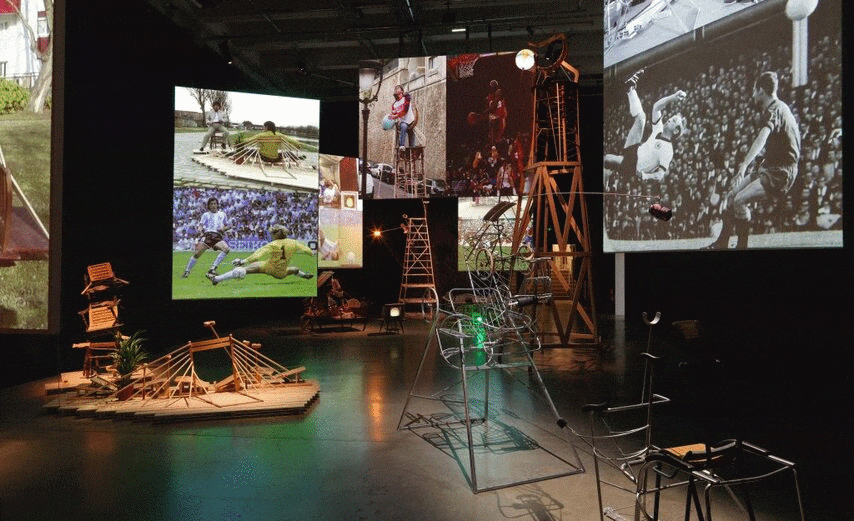ex
September 2–November 15, 2020
Paul Sacher-Anlage 1
4058 Basel
Switzerland
Hours: Tuesday–Sunday 11am–6pm,
Thursday 11am–9pm
tinguelybasel.infos@roche.com
Press preview: August 31, 4–6pm, You are kindly asked to sign up for this press preview (presse [at] tinguely.ch).
Opening Day: September 1, 11am–9pm
Special Day Taro Izumi: Video Screenings: September 20, 11am–6pm, Selection of early video works by the artist.
Special Day Taro Izumi: Curator’s Tour: September 20, 3–4pm, Guided tour of the exhibition by curator Séverine Fromaigeat.
Special Day Taro Izumi: Artist talk: September 20, 4–5pm, Conversation between the artist and the curator. (English)
Curator’s Tour: October 6, 12:30–1:15pm, Guided tour of the exhibition by assistant curator Anastasia Chaguidouline.
Family Sundays: October 18, 11:30am–5pm
Inclusion day: November 8, 11:30am–6pm
For his first large exhibition in Switzerland, the artist unfolds this unique creative universe, an organic ecosystem that closely intermingles sculpture, installation, performance, and video. A sculpture may become an installation, which in turn becomes the scenery for a performance, which then reappears on multiple screens throughout the exhibition space. Likewise, materials such as wood, textiles, plants, furniture, and all manner of found items are interconnected in structures that look like they have been cobbled together, but were nevertheless precisely assembled.
Absurdity, chance, accidents, and humor are constitutive elements of Izumi’s work. The journey he has imagined for Museum Tinguely is scattered with mirages and optical illusions: a theatre whose public has vanished, sculptures that imitate acrobatic positions, robotic vacuum cleaners suspended in space. Izumi creates antagonistic and often surrealistic object pairings, the meaning of which is usually mysterious, elusive. Cumulatively, the objects root themselves in the incongruities of our everyday lives to recount to us the gentle chaos of today’s world.
Reflecting on the unprecedented situation that has emerged with the advent of COVID-19, the Museum Tinguely presentation includes many site-specific works that echo our new cultural and social behaviours. They reflect on the new immateriality of our habits and the digital distance that has appeared in our relationships. The works speak of absence, emptiness, virtual presence, and places that have become inaccessible.
Over time, Izumi’s exhibitions have taken on an important immersive dimension. It is through the exhibition medium that the artist inhabits spaces and develops his narratives. This has led him to view the exhibition as a work of art in its own right. For Museum Tinguely, Izumi regarded every piece as a living organ that together compose the body of the show. The exhibition breathes, vibrates, moves, talks, sings, lights up. Screens are ubiquitous invaders: they punctuate the rooms, perch on the floor and ceiling, cling to walls, tilt in the air. On Izumi’s supports, video bewilders—it captures, it captivates, and it saturates the viewers’ attention as they continuously attempt to intercept it. An encounter with this lush, ever-expanding universe promises jumbles, bounces, and overlaps. It means entering a visual and mental kaleidoscope.
Catalogue
The show is accompanied by a catalogue that, for the first time, provides a comprehensive, in-depth account of Izumi’s work. It was produced in close collaboration with the artist, who selected and elaborated its iconographic corpus. Richly illustrated and containing critical essays and interviews, it examines his career in great detail. Translating an idea of circularity and constant movement, it can be read horizontally as well as vertically; it is a playful object meant to be observed, touched, and interpreted in many different ways. It unveils the artist’s recurrent themes, such as architecture, the animal world, and conceptual issues related to artistic creation. It includes a preface by Roland Wetzel, an extensive essay on Izumi’s artistic trajectory by Séverine Fromaigeat, a text on the ontological nature of his works by Keren Goldberg, a dialogue between architect Jun Aoki and curator Kenjiro Hosaka, a brief biographical description by Jean de Loisy, epistolary interludes by curator Gabriel Ritter, and zoologist Robert Zingg’s insight into the animal world.
Curator: Séverine Fromaigeat



